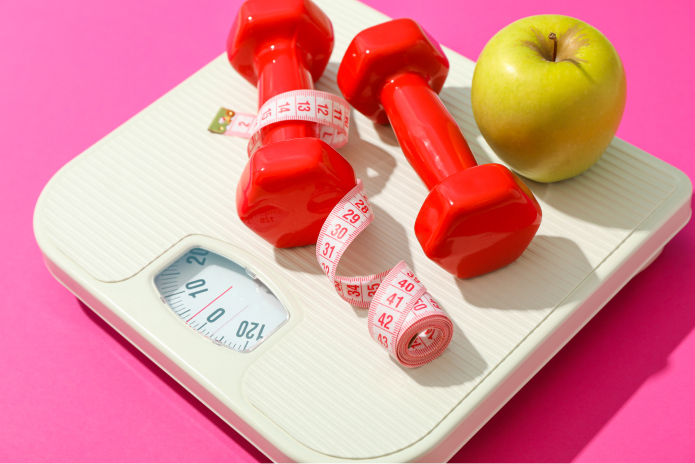With a new diet trend popping up seemingly on a weekly basis, it’s understandable that people get confused about how to properly diet to lose weight and keep it off long-term. To further complicate the situation, there is a ton of conflicting advice floating around about the right way to do it.
What exactly is the right way to do it? We’ll answer that question later in this article, and we’ll also review how your metabolism works and discuss the common mistakes people make that hinder their results.
Setting Expectations
Briefly, we wanted to include this caveat. First, everyone can lose weight. That said, not everyone can achieve the same results. This can be a discouraging thing to read, but it’s important to set your expectations based on your body type.
Genetics play a huge role in what you’re capable of from a physical fitness standpoint. Have you ever known someone who could eat an entire buffet every day of the week and never gain a pound? Or someone who never lifted a weight in their life but has bigger arms than 90% of the population? Yeah, those people… they’re genetically gifted from a physical conditioning standpoint.
They’re also the worst people to take advice from because they look the way they do based largely on their predetermined genetics and not because of any diet they follow or workout program they perform.
So, let’s just get that out of the way. Everyone can move the needle, but not everyone can achieve extraordinary results.
The Happy Zone and Homeostasis
Both concepts may be new to you, but they affect your body composition and influence your progress in a major way. Let’s take a closer look at both, and how they can help or hurt your progress.
The Happy Zone
Everyone has a set “happy range” where your body likes to stay when it comes to both fat and muscle accumulation. This is totally up to your genetics and there is nothing you can do to change it, at least not naturally anyway.
In the example above, the people who just look fit no matter what they do have a happy zone for fat and muscle composition that allows them to stay in that range without much effort.
The happy zone can be your best friend if you’re currently living outside of it. For example, if you have lived a lifestyle that has forced your body to store more fat than it would like to, getting back down to the happy zone will not take much effort outside of cleaning up your diet a bit and adding some physical activity. Depending on how far outside of the happy zone you are, it could take weeks, months, or years, but the progress will be steady.
Likewise, if you are already in the happy zone, any progress you attempt to make will be more difficult. More on that below when we discuss homeostasis.
Homeostasis
Homeostasis is like your body’s governor, like a speed governor on a golf cart that doesn’t allow you to fly down a hill at 50mph. Homeostasis, in short, means to stay the same. Your body loves homeostasis and once you’re in the happy zone, homeostasis will fight you every step of the way if you’re trying to make changes to your body.
Homeostasis can be a good thing though. For example, if you’ve done the hard work to get to a physical condition that you’re happy with, homeostasis will try to keep you there if you don’t make major changes to your diet or activity level, assuming you’re still in your body’s happy zone.
If you have gotten such great results that you were able to push your body outside of its happy zone, whether in regard to the amount of body fat being lower than it would like or the amount of muscle being higher than it would like, homeostasis won’t help you much because the happy zone rules all things. It will be very difficult to maintain such a level of conditioning, but it can be done. It just takes extreme dedication.
How to Achieve Sustainable Results
This is the big question. How do you get and stay at a level of conditioning that you want to be at? There is no one-size-fits-all answer, as you may have gathered from the above information. But there are some general rules you can follow to get results and keep them.
Diet

We are not going to take a deep dive into the diet aspect in this article. The reason for that is because different diets work for different people. Some people do well on a low carb, high protein, moderate fat diet. Others do better on a moderate carb, high protein, low fat diet.
And then there are the extreme diets, which involve zeroes for certain macronutrients. Macronutrients are proteins, carbs, and fats. Diets like the carnivore diet are zero carb, all meat diets high in protein and fat.
Generally, our preference is to stay away from extreme diets that involve zeroes for any of your macronutrients. They may work for some, but for others they can be disastrous.
No matter what your macronutrient percentages are, no diet will work for weight loss if you are consuming more calories than you burn. Let us repeat that again NO diet will work if you’re eating more calories than you burn. Doesn’t matter if you’re eating 100% “clean foods”, if your daily calorie intake is higher than your daily expenditure over the course of time, you will not lose weight.
We’ll leave the diet portion of this article here for now. The takeaway is that you must be in a caloric deficit, meaning you must burn more than you bring in. More on diet later.
Exercise

Everyone knows exercising helps you lose weight. And outside of that, cardiovascular exercise is good for your heart and weightlifting is good for your bones and muscle strength. But exercise itself, as it relates to weight loss, is a secondary tool. Diet is the main tool, and more specifically, being in a caloric deficit is the main driver of weight loss.
Exercise comes in to play to help you get into a caloric deficit without having to starve yourself to get there, and as we’ll explain below, there will come a point where your diet simply cannot change anymore, making exercise the only knob you can turn to ramp up the progress.
How Your Metabolism Functions
Most people know that a faster metabolism means you burn more calories at rest than if you have a slow metabolism. Keeping your metabolism fast is important for sustainable results. There are two ways to keep your metabolism fast.
One, exercise speeds up your metabolism. Two, eating speeds up your metabolism. So, if you caught the importance of that second point, good job. The more you eat, the faster your metabolism is.
But wait, you may say, we’re trying to lose weight, so we need to eat less. Doesn’t that slow our metabolism down? Yes, it does. This is the number one reason why people don’t stay motivated on a diet. Initially the results are great because they’re probably returning to their happy zone. But then, homeostasis kicks in and results get more difficult.
At this point you have two options, reduce your calories or increase your activity. Depending on how many calories you’re currently eating, at this first sticking point the general recommendation is to drop calories slightly. That is, unless you’re already eating very few calories for your body weight.
Most people are not eating too few calories at this point, so that is why we recommend adjusting down in calories instead of adjusting up in the activity department. We recommend a small reduction of about 100 calories per day.
You will see a drop in metabolism as you reduce your calories, and the drop in metabolism, coupled with homeostasis, will make the fat loss achieved by this calorie reduction less impactful than previous calorie drops. And this cycle repeats every time you drop calories. So, as you can see, this is where people get frustrated.
They’re eating less and less, but instead of losing 3-5lbs a week they’re only losing 1-2lbs a week. Don’t get discouraged! This is normal. In fact, losing more than 1-2lbs a week long-term, especially when you’re in your body’s happy zone, is not healthy.
It Only Gets Harder
Ok so you’ve lost a good bit of weight to bring yourself into your happy zone with not too much effort, but then you stalled out. You dropped your calories a bit more and you saw the weight loss pick back up, albeit at a slower pace. But now you’ve stalled again.
If you’ve been following this article, you know that was bound to happen because of homeostasis and metabolism changes. So don’t get discouraged, it is normal. At this point you again have the same two options you had at your last stalling point. Reduce calories or increase activity.
And again, it really depends on where you’re at with your daily caloric intake. But at this second stall, we recommend increasing activity for most people. You’ve already made two caloric adjustments: the initial one when you first got started, and the second one to get you past your first stall.
At this point your calorie intake becomes a weapon you must use very strategically, making sure not to get dangerously low and damage your metabolism. So, if you’ve been exercising for 30 min a day, bump it to 40. The increased activity and calorie burning will spur you past your sticking point, albeit probably a bit slower than what happened after your last sticking point.
The Grinding Phase
After you inevitably stall again, it’s time to employ some advanced tactics. This is where very few people have the knowledge or the discipline to succeed, but it is the right way to do it. Much of the information below comes from Dr. Mike Israetel, who explains this and much more in his video content here.
At this point we would drop the calories by about 200 per day for a 2-3 week period. This is a substantial drop and you’re going to feel it. You’ll be hungry and it will be hard. You might be wondering what effect this will have on your metabolism and that’s a fair question, and it’s where the advanced tactics come into play.
The reason you only hold this new calorie level for 2-3 weeks is to avoid a change in your metabolism. Homeostasis is about to start helping you, because it takes longer than 2-3 weeks for your body to adjust the metabolic rate down.
So, what you’re going to do is basically steal some time at a reduced calorie rate before your body has a chance to adjust the metabolism down. When 2-3 weeks is up, you must return to your previous calorie level. This is an absolute must. Do not get tempted to stay at this level and expect the fat loss to continue. You’ll probably drop 1-2lbs in this 2-3 week period and you may want to keep going, but do not.
After the 2-3 week period is up, you’re going to raise the calories back up by 200 per day. This is effectively your maintenance level of calories at this point, meaning you won’t be losing any weight. And this is hard to swallow for a lot of people. They feel that if the needle isn’t constantly moving then it’s not worth the effort, but it is physically impossible to keep the needle moving consistently once your body is in its happy zone and homeostasis is affecting you.
You have now entered the repeated grind cycle, where you bounce back and forth between maintaining and reducing. After you hold your maintenance level for 2 weeks, drop the calories again by 200 per day and repeat the process. Eventually this will stop working too, but hopefully by then you’ll have achieved the look you want.
If you still haven’t, don’t worry. There is more you can do. You’ll still alter between maintenance levels of calories and reduced levels, but you’ll bump your activity levels up again. This is where it gets extremely difficult especially during the caloric reduction weeks. You’ll be tired and your body will hurt, but you will ever so slowly make progress. It takes time, but it is going to happen.
Never get greedy and keep the calories below maintenance for more than 2-3 weeks at this point, and don’t overdo the increases to activity too drastically. Go up by 10 minutes per day at a time. See how your body responds for a few weeks.
Avoid Overtraining

You’ll need to start to understand the difference between good tired and bad tired. Good tired is ok. Bad tired is when you’re approaching overtraining, which is a real progress killer. If you are starting to have trouble sleeping at night, that is a tell-tale sign of overtraining. So are injuries that won’t heal, like tendonitis. If these things are starting to happen, you need to take a break.
Most people never get to the point of true overtraining, but if you’ve made it to this point where you’re in the grind phase, it can happen. Take a week off if you’ve approached overtraining, set your calories to your maintenance level or maybe even slightly above. Don’t do any workouts. Just rest and recover, and make sure you get good sleep.
Don’t worry about gaining weight. Homeostasis will not allow you to gain weight back in such a short time, provided you don’t binge eat for a week. Trust the process. Stay the course and take the time to recover so you can push hard again when you return.
The Conclusion
Depending on how far you go into your body’s happy zone, and especially if you get outside of your body’s happy zone, the results you achieve will be harder to maintain. But the good news is that because it has probably taken you a long time to get there, guess what becomes your best friend. That’s right, homeostasis.
If it took you 2 years of following the above protocol of grinding between maintenance and slightly reduced calorie levels, then your body has reset its homeostasis point to where you currently are. That’s not to say it doesn’t want to gain some weight back if you’re well below its happy zone. But it won’t be a drastic rebound if you don’t completely fall off the wagon.
At this point you should be able to slowly raise the calories up a bit while keeping your exercise level high. The key word there is slowly. Raise by 100 per day at first, hold there for a few weeks, then add another 100. See what happens.
You probably won’t gain much fat back, if any. If you can maintain here, at this point, you’re at the finish line. You can still have your cheat days and fun without worry. They will do absolutely nothing to your body composition if they’re kept to a reasonable minimum.
Congratulations if you made it to the end of this article. We hope it was informative. This is information you don’t read very often, rather, what you see is the latest fad diet or supplement that is supposed to be the magic pill.
There are no magic pills, only hard work, dedication, and strategic moves that work over the course of time. Good luck on your journey!




